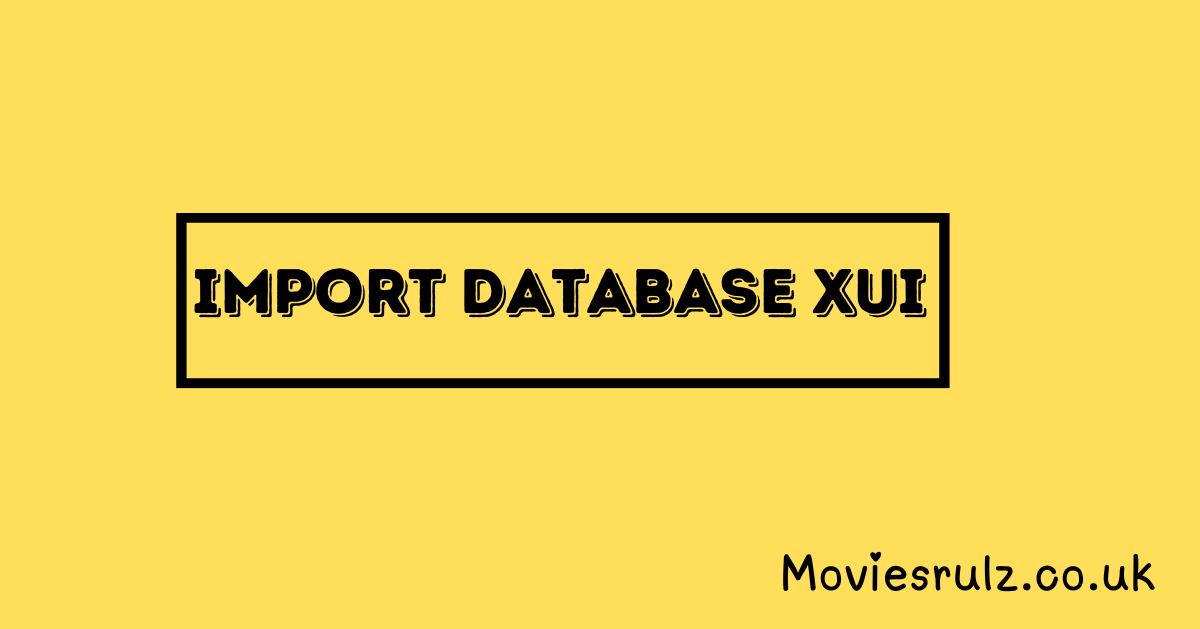Technology
Import Database XUI: A Comprehensive Guide for Beginners

XUI, or Xen Unified Interface, is a modern platform designed for database management. It simplifies tasks like database importation, user configuration, and backend management. Many developers favor Import Database XUI for its efficiency, flexibility, and user-friendly interface, making it ideal for handling complex data operations.
Understanding Database Imports in XUI
Database imports involve transferring data from an external source into the XUI environment. This process is essential for organizations managing large datasets, migrating systems, or integrating applications.
Advantages of Importing Databases in XUI
XUI offers several benefits for database imports, such as automation, speed, and reduced error margins. Additionally, it provides seamless compatibility with various database formats, enabling better scalability and integration.
Prerequisites for Importing a Database
Before you start, ensure you have:
- A valid XUI setup installed on your system.
- Database files in a compatible format like SQL or CSV.
- Administrative access to the XUI platform.
How to Prepare for Database Import
Preparation is crucial for a smooth import process. Organize your files, verify data consistency, and back up your current database. Also, check that the database schema aligns with XUI’s requirements.
Steps to Import Database XUI
Log Into XUI
Access the Import Database XUI platform using your administrator credentials. Navigate to the dashboard for database management.
Choose the Import Option
Locate the “Import Database” function in the settings or database management tab. Select the feature to begin the import process.
Upload Your Database File
Browse and upload the file you want to import. Supported formats typically include SQL, JSON, and CSV.
Map Data Fields
Import Database XUI provides an option to map fields between the imported file and the existing database schema. Ensure field alignment to avoid mismatched data.
Initiate the Import
Click “Import” and monitor the progress via the status bar. The platform will process the data and integrate it into the existing database.
Common Challenges During Import
- File Compatibility Issues
Ensure your file format is supported. Convert files if necessary before attempting the import. - Data Mapping Errors
Mismatched fields can disrupt the import process. Double-check your mapping settings for accuracy. - Server Timeouts
Importing large databases can lead to timeouts. Optimize your server settings or split the database into smaller chunks.
Tips for a Smooth Database Import
- Always validate data for accuracy and consistency before importing.
- Test the import process using sample data.
- Maintain proper backups to recover from potential issues.
Verifying the Imported Database
After the import, review the newly integrated data to confirm accuracy. Import Database XUI allows you to preview and test imported datasets, ensuring functionality and completeness.
Optimizing Database Performance in XUI
To enhance performance:
- Regularly update Import Database XUI to the latest version.
- Optimize database queries.
- Monitor system resources during large imports.
Troubleshooting Import Errors
- Error Logs: Check error logs provided XUIfor specific details.
- Format Validation: Verify the file structure and format.
- Support Channels: Utilize XUI’s community forums or support team for help.
Why Businesses Rely on XUI for Database Management
Businesses choose XUI for its adaptability, user-centric design, and robust import capabilities. It reduces manual workload, improves efficiency, and supports scalable operations.
Future Trends in Database Management
As technology evolves, platforms like XUI are expected to integrate AI-driven tools, enabling predictive analytics and automated database maintenance.
Conclusion
Importing Import Database XUI is a straightforward yet vital task for efficient data management. By following best practices and leveraging XUI’s features, you can ensure a seamless import process, optimize database performance, and maintain data integrity.
FAQs
What file formats are supported by XUI for imports?
XUI supports popular formats like SQL, CSV, and JSON for database imports.
Can I import large databases into XUI?
Yes, but it’s recommended to split large files into smaller segments to prevent timeouts.
How do I handle errors during the import process?
Check XUI’s error logs and ensure your file format is compatible. For persistent issues, contact support.
Is XUI suitable for beginners?
Absolutely! XUI’s user-friendly interface and guided import process make it perfect for all experience levels.
How often should I update XUI?
Regular updates are essential to access new features, bug fixes, and performance enhancements.
-

 Entertainment11 months ago
Entertainment11 months agoMoviesRulz: Your Ultimate Guide to Streaming Blockbusters Online
-

 Sports10 months ago
Sports10 months agoReddit Soccer Streams and Alternatives for Sports Fans
-

 Sports11 months ago
Sports11 months agoViprow.us.com Odds: Understanding Sports Betting Benefits
-

 Buisness11 months ago
Buisness11 months agoPokémon Infinite Fusion Calculator: Your Ultimate Guide
-

 Education11 months ago
Education11 months agoHow to Use JoinPD Engaging Classroom Experiences
-

 Entertainment11 months ago
Entertainment11 months agoNhentai.nef: Understanding Its Role and Impact in Digital Media
-

 Entertainment10 months ago
Entertainment10 months agoIncestflix: Understanding the Controversy and Its Implications
-

 Buisness10 months ago
Buisness10 months agoThe Online Market Business in the UK: Statistics, Growth and Opportunities
